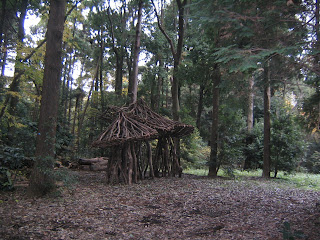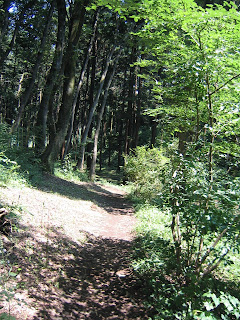I planned to
write about Laboratory of the Forest 森ラボ when the annual art exhibition
starts. Then, the latest news told me there is a slight change in the “venue”
of the exhibition in 2015, and the previous places could be off-limit for about
2 years soon. So I decided to write about Forest Lab in 2 installments: one for
the actual 2015 Event, and another is this post for the installations of
previous exhibitions.
As I posted in last May, this forest is a planned area for botanical part of Yokohama Animal Forest 横浜動物の森公園. This April, animal part, i.e. Zoorasia, has completed its development and opened its entirety to the public. Now this is a turn for botanical section to sort things out. Moreover, in 2017 City of Yokohama presides over the 34th National Urban Greenery Fair 全国都市緑化フェア, where Prince Akishino 秋篠の宮, the younger brother of the Crown Prince, opens the event as his annual royal duty. The botanical section of Yokohama Animal Forest becomes one of the two venues of this national event (; another venue is Minato-mirai). The preparation begins this summer. According to GROUP the Creation and Voice of the Woods, the area next to the parking of Zoorasia will be soon closed temporarily for 2017 event. Let me introduce you what were there in this post.
The access to the forest is either from the west, i.e., Zoorasia, or from the east, i.e. Shikinomori Park 四季の森公園. From Zoorasia, I posted the way in May. The Forest does not have a parking, but Zoorasia Parking is available for 1,000 yen (for an entire day; hmmmmm, a bargain). From the east, you can either climb up the hill of Shikinomori Park to find Nishi-Hikarigaoka 西ひかりが丘 bus stop, or take bus. If you choose bus from JR Yokohama station, it is Sotetsu bus Asahi 10 line to Yokohama Zoorasia. (Its time table here.) Get off the final stop, and the rest is as I wrote in May. Another bus option is from either JR Nakayama 中山 station or Sotetsu Tsurugamine 鶴ヶ峰 Station. There are the routes Asahi 11, 13, 14, and 15 all of which connect two stations. (From Nakayama, the time tables are here and here. From Tsurugamine, the tables are here.) For weekends, the bus from Nakayama goes to Tsurugammine via Zoorasia so that you can enter the forest from the west if you take this bus. Otherwise, if you ride the bus from Nakayama, get off the bus at Kohdan-Shukaijoh-mae 公団集会場前. If you turn right from the bus stop, beyond the traffic light, you’ll find a building looks like an old school. It is now closed Hikarigaoka Elementary School ひかりが丘小学校 (as this Hikarigaoka Housing Complex becomes the town of elderly people with very few kids). If you ride the bus from Tsurugamine for Nishi-Hikarigaoka, it actually takes you in front of this building at the bus stop, called Nishi-Hikarigaoka.
 |
| Kohdan-Shukaijoh-mae
stop if you take a bus from Nakayama |
 |
| Nishi-Hikarigaoka
stop if you take a bus from Tsurugamine |
 |
| Former
Hikarigaoka Elementary School seen from the direction of Yokohama Animal Forest |
You walk to the gate of Hikarigaoka Elementary. On the left, there is the South Gate of Kanagawa University High School 神奈川大学付属中高 (within a kind of forest which, of course, we cannot trespass). Walk toward this direction for 30 m or so, we meet a T-crossing. Turn left and proceed about 50 m ahead. On the left is a housing complex, and on the right is a forest, the botanical part of Yokohama Animal Forest. At the edge of the forest, we see a swamp below the road, and steep steps that leads us to the promenade running along the swamp. Over the swamp, on the left of us is the venue for 2015 Laboratory of the Forest. 8 artists start working for their installation from August 2nd. Their work in progress is for public viewing so that if you go there before the actual exhibition starts on August 30, it would be possible to have a chat or two with them. I post my report at the end of August for this year’s exhibition. J
 |
| The forest to be Yokoham Animal Forest |
 |
| Going down this steps, |
 |
| On the left is the place for this year’s exhibition, and, |
 |
| On the
right is the way to the site for previous years’ exhibition. |
 |
| During
summer, the swamp is covered by tall Phragmites australis. |
 |
| But early spring, we can enjoy this vista. |
Walk the way along the swamp, it eventually brings us to a small open space. It was the entrance of previous exhibitions where several totem poles greeted us.
 |
| Like this |
I hope those installations will be there for the new site. Anyway, from here we find 3 roads. The paved road ahead leads us to Miho-Niiharu towns. The road immediately on the left keeps going along the swamp leads us directly to the entrance of the forest next to the parking lot of Zoorasia. This part of swamp is not that wet, and the GROUP held before a puppet show using a log felt over the dry swamp. The road was also used for several shootings of TV samurai drama. Yeah, the atmosphere is a kind of “300 years ago the road was like this in Japan.”
 |
| For sward-fighting lovers |
 |
| Open air theatre for puppets |
Another road at the left bottom of the open space is into the forest, and the main route for previous exhibitions. There still remains a whiff of previous installations, like …
 |
| Into the woods, |
 |
| It was an installation several summers ago. |
 |
| Well, those white poles were not fences, but art. |
And few minutes’ walk in the woods leads us to another open space where before several small sculptures greeted us. I hope the GROUP moved them too to the new venue.
 |
| Open space now ... |
 |
| and then. |
From the end of open space, a bit of climb and go along one road, we eventually reach to the open space next to the entrance from Zoorasia parking lot. Along the way, the exhibition presented several interesting installations. For example
 |
| It was
an installation using fiber optics with solar generator. |
 |
| Now it becomes like this. |
 |
| This
one was interesting. It enclosed a space within the forest with yellow construction tape for the exact size of the space of a condo the artist lived in downtown. It was tiny, honestly. |
 |
| An homage to dying bagworms |
The open space next to Zoorasia-side entrance was for large presentations, and picnic. It is now empty with logs here and there. All are gone … sad, sad …
 |
| Now |
 |
| Then |
 |
| By
Kestutis Benedikas from Lituania “Sprit of Tree.” |
 |
| It is now, at the end of July 2015. |
 |
| I
personally loved this one best. “Pyramid of Life” by James Robert KokoBi from Cote d’Ivoire. |
Looking over the parking lot, the way to the right is to Miho village as I posted in May. On the left, there are two road; the immediate right one brings us to the place for this year’s exhibition. Another goes down is the way from the entrance from Shikinomori Park connecting to Zoorasia. This part also had several installations, aside from TV film shooting locations.
 |
| An
artist tried to create “ordinary garden” within the forest. This is the result, ha ha. |
8th Art Exhibition in the Forest of Yokohama, 2015, titled “Shinso Kaiten 森創開展,” starts on August 30. I hope this years’ exhibition gives us again inspirations within the forest. The 2015 venue is in the forest we have seen beyond the swamp before coming to the place of this post. As a related event, during August 23 - September 13 there will be an exhibition for the concept of the event, “Woods-ArtLand-Town,” in the concourse of Nakayama Station of Yokohama City Subway. On August 23, there is an event in the exhibition forest to create an installation with flags by anybody who bother to go there. (10:00-14:00, free. The event will be continued during the exhibition every weekend.) The opening of the exhibition is August 30, with artists presenting their installations by themselves. + From 13:00, there will be open-air concerts by Sushi-oke Drum Fu-chin すし桶ドラムふーちん, SORA, and Naoyuki Tsuchiya 土屋直之. During the show, the art-tour will be held every Sunday and National Holidays from 11:00. Every Sunday during the exhibition, there are events to play with the forest and art for 10:00-15:00. I write you for the detail in another post for this year’s exhibition.
If you find a problem in the site
introduced in this post, the best contact address will be GROUP the Creation
and Voice of the Woods. The events also receives grants from Culture and Tourism
Bureau of the City 横浜市文化観光局.
The contact address of the Bureau is
Minatocho,
Naka-ku, Yokohama, 231-0017
TEL: 045-671-3715 FAX: 045-663-5606
URL: http://www.city.yokohama.lg.jp/bunka/bunshin/torikumi/artsite/TEL: 045-671-3715 FAX: 045-663-5606





































